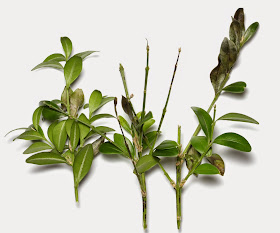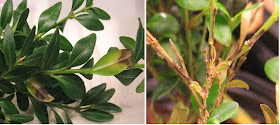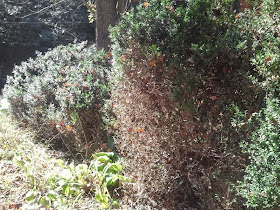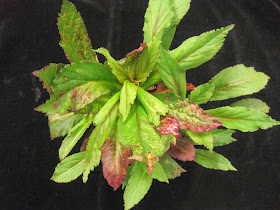Note to the reader: This blog was originally published in December 2014. The first paragraph was updated in 2016 to reflect changes in the intervening years.
Boxwood blight has been a problem in North Carolina since it was first found here in the fall of 2011. At first it was primarily a problem for the nursery industry, but it has been found in an increasing number of landscapes across the state. Now, according to NCDA&CS plant pathologist Leah Roberts, there are widespread reports this month [November 2016] of boxwood blight on holiday greenery being sold at retail outlets. For this reason we are re-publicizing this 2014 blog post.
The situation took a new turn this month [December 2014] with the discovery by the North Carolina Department of Agriculture and Consumer Services of boxwood blight in boxwood holiday greenery sold at retail
stores in a few North Carolina locations. We do not know how widespread this
disease is on boxwood tips sold for holiday greenery, but this alert is being
distributed to avoid potentially irreversible damage to established boxwood
plantings. It is written for purchasers of boxwood wreaths or other holiday
greenery made from boxwood. Tip growers and nursery operations should consult
with their local County Cooperative Extension Service or the NCDA&CS Plant Protection Section.
Boxwood blight has been a problem in North Carolina since it was first found here in the fall of 2011. At first it was primarily a problem for the nursery industry, but it has been found in an increasing number of landscapes across the state. Now, according to NCDA&CS plant pathologist Leah Roberts, there are widespread reports this month [November 2016] of boxwood blight on holiday greenery being sold at retail outlets. For this reason we are re-publicizing this 2014 blog post.
 |
| Boxwood blight on tips from a holiday wreath. Photo (2014) by Matt Bertone, NCSU PDIC. |
 |
| Dark leaf spots (left) and dark stem streaks and defolation (right) are typical boxwood blight symptoms. |
Affected boxwood show three main symptoms:
- dark leaf spots
- dark streaks on green twigs
- leaf drop.
Boxwood blight is caused by a fungus known scientifically as Calonectria pseudonaviculata. It also goes by the names Cylindrocladium pseudonaviculata and Cylindrocladium buxicola. The fungus is harmless to other kinds of plants, to animals, and to people.
 |
| Defoliation typically begins near the base of the boxwood plant and moves upward. Photo by Kelly Ivors. |
What should you do if you have boxwood greenery for the
holidays? As a precaution, we are recommending the following:
(1) Inspect boxwood greenery for blight, and immediately discard suspicious material, including fallen leaves.
(2) If there are boxwood shrubs in your landscape and if any boxwood greenery has been placed in an area where it is exposed to rainfall, relocate the greenery or bag and discard it. Do not handle the material when wet, because you could easily spread the spores.
(3) At the end of the holiday season, bag up all boxwood greenery and dispose of it in a landfill. Do not place it in the compost.
(4) Monitor nearby boxwood plantings for symptoms of the disease.
(1) Inspect boxwood greenery for blight, and immediately discard suspicious material, including fallen leaves.
(2) If there are boxwood shrubs in your landscape and if any boxwood greenery has been placed in an area where it is exposed to rainfall, relocate the greenery or bag and discard it. Do not handle the material when wet, because you could easily spread the spores.
(3) At the end of the holiday season, bag up all boxwood greenery and dispose of it in a landfill. Do not place it in the compost.
(4) Monitor nearby boxwood plantings for symptoms of the disease.
More information about this disease, including more
photographs, can be found on NCSU’s Plant Pathology Portal. The Virginia Boxwood Blight Task Force web page
is also a good reference and includes lists of best management practices for
different situations.




















